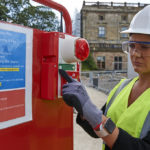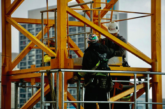Temporary fire solutions have become a crucial part of building safety for local authorities — particularly within complex scenarios and throughout construction or renovation phases. Protection of human life is of the utmost importance, and for the public sector, it is of huge benefit if the solution is also time and cost-effective. Adam Jurka, National Sales Manager at wireless solutions firm Ramtech, explains the role of short-term fire safety measures, and how local authority building managers can mitigate risk through innovative technology.
When a permanent fire safety system fails, this presents local authority building owners with a challenge to quickly provide safety cover. This can happen when there is damage to a permanent fire alarm system that leaves it in need of repair, or unexpected malfunctions that mean a replacement is necessary.
As repairs or replacements are not always immediate due to time, financial, or other logistical constraints, by using a temporary system, this will afford local authorities and public sector services precious time and peace of mind while any issues are being resolved with the permanent system.
Waking watches or ticking time bombs?
In the aftermath of the fatal Grenfell Tower fire, interim safety arrangements came into place for the hundreds of other buildings in the UK with dangerous cladding. However, more than four years on, residents in these properties are still relying on temporary measures in case a fire breaks out.
This is a no-win situation for anybody involved. Residents aren’t as safe as they should be in their homes, and while the argument rumbles on over who pays for what, short-term measures such as waking watches have ended up costing as much, if not more, than replacing the cladding in the first instance.
At its most basic, waking watch teams or fire warden patrols involve a person or team patrolling buildings, then alerting residents to evacuate in the event of a fire. For large structures, a person on each floor may be required, which can soon add up. According to Inside Housing, the cost of doing this — potentially for local authority housing — can be as high as £500,000 a year per building.
Building owners must now look to pivot their approach and find more cost-effective ways of maintaining vigilance while not relying on the vagaries of human error.

Time sensitive tactics
Repairing or replacing a damaged permanent wired fire alarm system can be a lengthy process. The good news is that a wireless system does not require the same sort of installation. In fact, wireless solutions can be set up in minutes and in some instances can be rented out at short notice. For instance, as the Covid-19 pandemic emerged, NHS services had to adapt quickly, often with temporary spaces created, to contain the virus and prevent the spread of infection. This was escalated with the creation of the Nightingale hospitals, such as at London ExCeL.
The temporary field hospital, which was constructed in under a week, had the capacity to treat up to 4,000 coronavirus patients. To protect the temporary buildings quickly, the WES3 wireless alarm system from Ramtech was used and linked to a control panel in the security hut on site. It used best quality Category 1, Euro-harmonised radio, meaning it would not interfere with other technologies used at ExCeL. Any activations were then communicated to the ExCel security suite via G4S by radio.
Complex connections
As well as for temporary structures, major public sector projects also benefit from temporary fire solutions for the duration of onsite works. During complex projects such as the Thames Tideway Tunnel, a wireless system enabled better connectivity across a large, difficult site.
The creation of the major ‘Super Sewer’ in London was designed to prevent the River Thames being polluted by tens of millions of tonnes of overflow sewage that currently flow into the river each year. The ambitious 25km tunnel runs below the River Thames in a complex route across central London.
This highly challenging engineering project comprised of multiple construction sites and WES3 was specified by the joint venture team to deliver EN54 compliance across the West section of the Tunnel project. It was connected to the cloud-based REACT system, so the project team were able to utilise for planning emergency procedures, as well as ensuring they have real-time updates of any onsite emergencies.

Long-term projects
A temporary wireless fire alarm system should also be factored into the planning for use during periods of building and construction works. Protecting 1,000 years of history at Nottingham Castle from the risk of fire during its significant £30m refurbishment was an incredible undertaking. Ensuring that the heritage is protected for generations to come during this ambitious project that spanned three years, was vital.
On top of the practical fire safety concerns, heritage projects have the added concern of protecting the building fabric from any unnecessary alterations to maintain its historical value. So, choosing a fire protection system that does not rely on an external power source and does not impact the fabric is another consideration.
Our solution covered the entire site and delivered exact location information should a fire have broken out. The units could span any distance by utilising their innovative ‘flooded mesh’ radio network. Its connection with our cloud-based system also provided 24/7 coverage on the city centre site.
Taking ownership of fire safety
Wireless fire alarm safety systems ensure that local authority buildings, whether residential or commercial, can continue to operate safely. This investment will offer peace of mind to the building owners and prevent delays when facing unpredictable circumstances. Not to mention how they help building owners, their contractors, occupants, and the wider public stay safe — when waiting for a permanent solution. With the help of experienced wireless technology specialists such as Ramtech, the right temporary wireless fire alarm solution can be quickly deployed to ensure that there is never a gap in safety.









